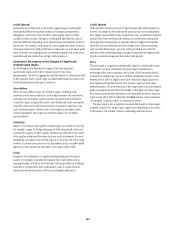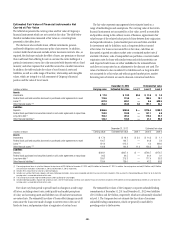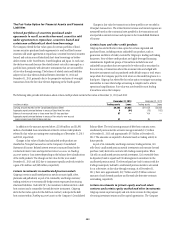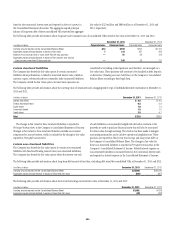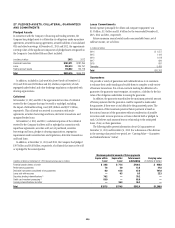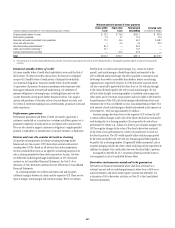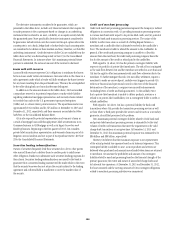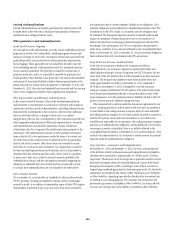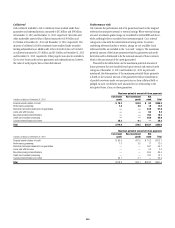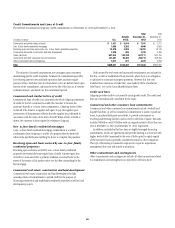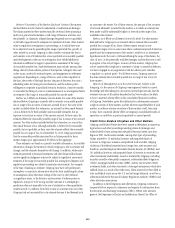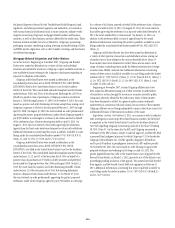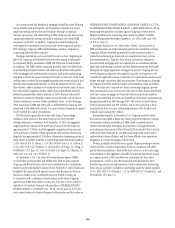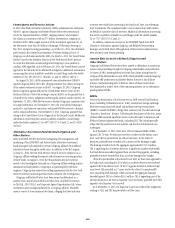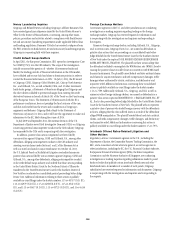Citibank 2013 Annual Report Download - page 316
Download and view the complete annual report
Please find page 316 of the 2013 Citibank annual report below. You can navigate through the pages in the report by either clicking on the pages listed below, or by using the keyword search tool below to find specific information within the annual report.298
The derivative instruments considered to be guarantees, which are
presented in the tables above, include only those instruments that require Citi
to make payments to the counterparty based on changes in an underlying
instrument that is related to an asset, a liability, or an equity security held by
the guaranteed party. More specifically, derivative instruments considered to
be guarantees include certain over-the-counter written put options where the
counterparty is not a bank, hedge fund or broker-dealer (such counterparties
are considered to be dealers in these markets and may, therefore, not hold the
underlying instruments). Credit derivatives sold by Citi are excluded from the
tables above as they are disclosed separately in Note 23 to the Consolidated
Financial Statements. In instances where Citi’s maximum potential future
payment is unlimited, the notional amount of the contract is disclosed.
Loans sold with recourse
Loans sold with recourse represent Citi’s obligations to reimburse the buyers
for loan losses under certain circumstances. Recourse refers to the clause in a
sales agreement under which a lender will fully reimburse the buyer/investor
for any losses resulting from the purchased loans. This may be accomplished
by the seller taking back any loans that become delinquent.
In addition to the amounts shown in the tables above, Citi has recorded
a repurchase reserve for its potential repurchases or make-whole liability
regarding residential mortgage representation and warranty claims related
to its whole loan sales to the U.S. government-sponsored enterprises
(GSEs) and, to a lesser extent, private investors. The repurchase reserve was
approximately $341 million and $1,565 million at December 31, 2013 and
December 31, 2012, respectively, and these amounts are included in Other
liabilities on the Consolidated Balance Sheet.
Citi is also exposed to potential representation and warranty claims as
a result of mortgage loans sold through private-label securitizations in its
Consumer business in CitiMortgage as well as its legacy Securities and
Banking business. Beginning in the first quarter of 2013, Citi considers
private-label securitization representation and warranty claims as part of its
litigation accrual analysis and not as part of its repurchase reserve. See Note
28 to the Consolidated Financial Statements.
Securities lending indemnifications
Owners of securities frequently lend those securities for a fee to other parties
who may sell them short or deliver them to another party to satisfy some
other obligation. Banks may administer such securities lending programs for
their clients. Securities lending indemnifications are issued by the bank to
guarantee that a securities lending customer will be made whole in the event
that the security borrower does not return the security subject to the lending
agreement and collateral held is insufficient to cover the market value of
the security.
Credit card merchant processing
Credit card merchant processing guarantees represent the Company’s indirect
obligations in connection with: (i) providing transaction processing services
to various merchants with respect to its private-label cards; and (ii) potential
liability for bank card transaction processing services. The nature of the
liability in either case arises as a result of a billing dispute between a
merchant and a cardholder that is ultimately resolved in the cardholder’s
favor. The merchant is liable to refund the amount to the cardholder. In
general, if the credit card processing company is unable to collect this
amount from the merchant, the credit card processing company bears the
loss for the amount of the credit or refund paid to the cardholder.
With regard to (i) above, Citi has the primary contingent liability with
respect to its portfolio of private-label merchants. The risk of loss is mitigated
as the cash flows between Citi and the merchant are settled on a net basis and
Citi has the right to offset any payments with cash flows otherwise due to the
merchant. To further mitigate this risk, Citi may delay settlement, require a
merchant to make an escrow deposit, include event triggers to provide Citi
with more financial and operational control in the event of the financial
deterioration of the merchant, or require various credit enhancements
(including letters of credit and bank guarantees). In the unlikely event
that a private-label merchant is unable to deliver products, services or a
refund to its private-label cardholders, Citi is contingently liable to credit or
refund cardholders.
With regard to (ii) above, Citi has a potential liability for bank card
transactions where Citi provides the transaction processing services as well
as those where a third party provides the services and Citi acts as a secondary
guarantor, should that processor fail to perform.
Citi’s maximum potential contingent liability related to both bank card
and private-label merchant processing services is estimated to be the total
volume of credit card transactions that meet the requirements to be valid
charge-back transactions at any given time. At December 31, 2013 and
December 31, 2012, this maximum potential exposure was estimated to be
$86 billion and $80 billion, respectively.
However, Citi believes that the maximum exposure is not representative
of the actual potential loss exposure based on its historical experience. This
contingent liability is unlikely to arise, as most products and services are
delivered when purchased and amounts are refunded when items are returned
to merchants. Citi assesses the probability and amount of its contingent
liability related to merchant processing based on the financial strength of the
primary guarantor, the extent and nature of unresolved charge-backs and
its historical loss experience. At December 31, 2013 and December 31, 2012,
the losses incurred and the carrying amounts of Citi’s contingent obligations
related to merchant processing activities were immaterial.


